EEmcDevPi0Maker
- 1.8 M emcCalPP events
- 15,400 EHT triggers in sector 5
- 2x more expected, sector 5 appears cold in P plots
- Seed threshold 1.0 GeV
- Require highest tower in sector 5 and Ec > 4 GeV
- Shape limit of 0.5
As a reminder, we can calculate the mass from
Mgg = Ecluster ( 1 - zgg2 )1/2 sin(φgg/2)
Where
zgg = |E1 - E2| / (E1+E2)
is found from the energy deposited in the SMD for each gamma.
Strategy 1
For lower energy events, below 9.0 GeV, apply a simple strategy for
fitting the event. Plots are for an 8 GeV pi0 candidate.
- Find the highest strip in the U and V planes, fit a single shower around this point.

- Subtract the fit from the intial histogram to form the residual.
- Based on the mean of the single-peak fit and the mean of the SMD distribution, we know which side to search for the 2nd peak. Based on the variance of the SMD distribution, we can estimate its position.

- Using the initial fit and the fit to the residual, we fit 2 showers to the SMD U and V planes. These are two independent fits for now.

Fit results
mSector = 4
mSubsector = 2
mEtabin = 4
mMass = 0.103188
mXF = 0.0434745
mMomentum:
long = 7.97986
trans = 3.45296
mEnergy = 8.69489
mZgg = 0.62907
mDgg = 18.6012
mPhigg = 0.0305349
mZggU = 0.649992
mZggV = 0.608147
mDggU = 11.7717
mDggV = 14.4026
mPhiUV = 0.885578
Strategy 2
Higher energy events (where the SMD peaks begin to merge) cannot be
reliably fit using the above fitting algorithm. The following strategy
is applied. Plots are for a 14 GeV pi0 candidate.
- Find the highest strip in the U and V planes, fit a single shower around this point.
- Based on the mean of the SMD distribution, restrict the fit to an asymmetric range -1.5 σ to +3.5 σ if the mean of the SMD distribution is less than the mean of the fit. This provides an estimate of the mean and yield of the shower which is less biased by the presence of the neighboring shower.

- Subtract the fit from the intial histogram to form the residual.
- Based on the mean of the single-peak fit and the mean of the SMD distribution, we know which side to search for the 2nd peak. Based on the variance of the SMD distribution, we can estimate its position.

The two peak fit doesn't seem to reliably converge here based on the
initial starting point from these two fits. The following procedure
seemds to be fairly reliable...
- Initialize a 2 peak fit using parameters derived above.
- Fix the parameters which correspond to the less energetic gamma, fix widths of both to 1.25 (arbitrary), and fix the mean of the more energetic gamma.
- Perform the fit.
- Release the means and yields, and refit.

mSector = 4
mSubsector = 3
mEtabin = 6
mMass = 0.09288
mXF = 0.0699365
mMomentum:
long = 12.5838
trans = 6.10682
mEnergy = 13.9873
mZgg = 0.0864731
mDgg = 8.28423
mPhigg = 0.0133307
mZggU = 0.180701
mZggV = -0.00775485
mDggU = -4.89157
mDggV = -6.68587
mPhiUV = 2.20244
Mass spectra
Figure 1 shows "raw" mass spectra, i.e. no cuts other than we require
a cluster consistent with a high-tower trigger in sector 5... i.e. a
cluster with Ec > 4 GeV.
Figure 1 -- Mass spectrum
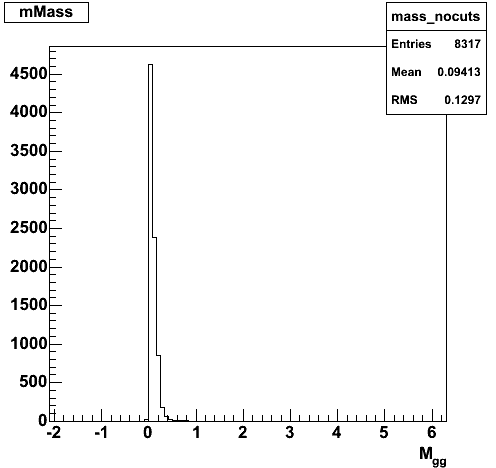
Figure 2 adds two additional constraints. First, zgg must
make sense. Second, we require that the SMD response in one plane is
inconsistent with a single gamma. This is achieved in the following
way. We integrate the residual histogram (SMD response - single-peak
fit). We take the ratio to the sum over the SMD distribution, and
require that it exceeds 30% in either U or V.
Figure 2a -- Residual cut
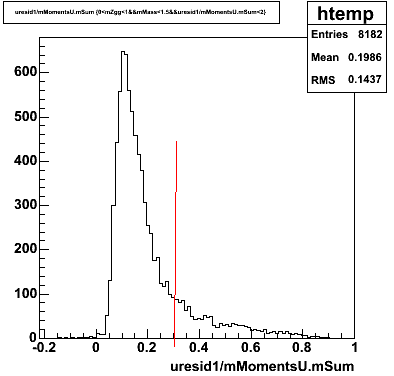
Figure 2b -- Mass spectrum, 0 < zgg < 1, single residual cut
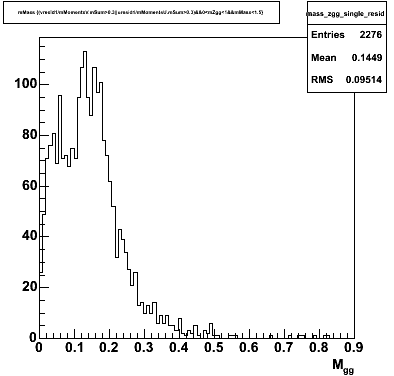
Finally, we require that the residual after the double-peak fit accounts
for at least 75% of the SMD response in both planes. Mass spectrum in
figure 3.
Figure 3 -- Mass spectrum after cuts on 2 peak residual

Figure 4 -- Energy spectrum of π0 candidates

Figure 5 -- φgg vs Ecluster
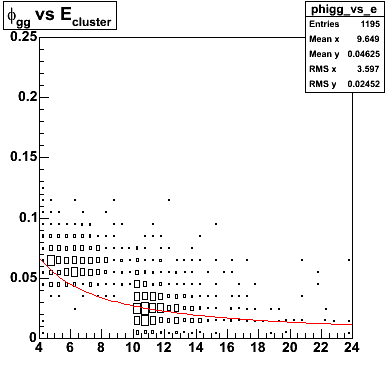
07/27/2004
Mass spectrum for Monte Carlo events in 5 energy bins. Energy dependence
needs to be figured out. note-- gains used below not necessarily correct.
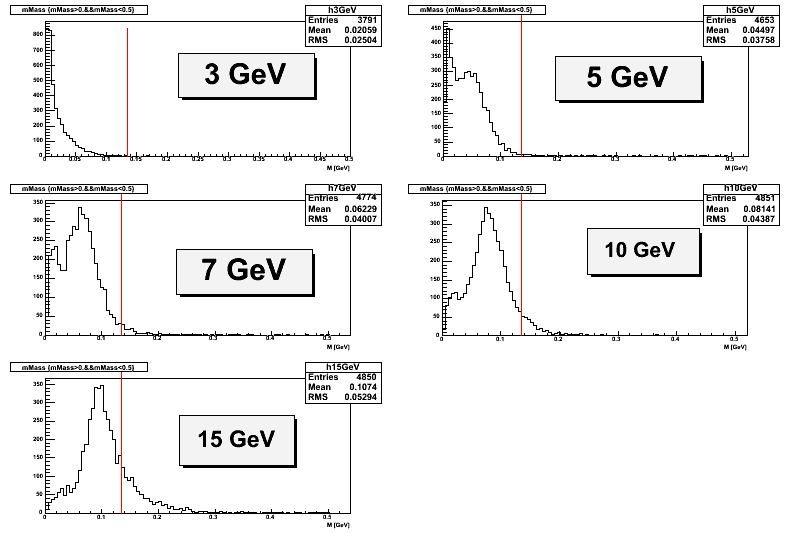
08/01/2004
For speed, only the initial single-shower fit plus the fit to the residual
are used in the SMD analysis. We do not do a two-peak fit to the SMD.
The energy-dependence is likely due to the fact that at 7 GeV, a pi0's minimum
opening angle is about the same size as the width (in phi direction) of 06TC04.
Since the cluster-finder only clusters towers adjacent to a single seed tower,
we lose a (potentially) significant amount of energy and we "lose" the SMD strips
beneath the missed towers as well.
Below 10 GeV in the Monte Carlo, we still have a significant number of events
which reconstruct to very-small (< 0.05 GeV) masses. Reason unknown.
A fairly large number of these have the second peak missing in the SMD distribution.
This is just a guess, but perhaps these are highly asymmetric events where we
lose the second peak below the conversion (Int_t)adc ...
08/05/2004 -- Revised Algorithm
- Find seed towers with energy in excess of specified threshold (0.8 GeV)
- Add neighboring towers to a cluster
- Find towers in cluster which exceed a specified threshold (0.6 GeV)
- Add neighboring towers to the cluster. Repeat till done.
- Consider SMD strips beneath the cluster.
- Use 5-strip sliding integral to determine highest-strip.
- Fit 5-parameter shower shape with only integral being a free parameter.
- Compute residual histogram, and repeat previous two steps.
- Use fits to share energy deposition between the two peaks. e.g.
w1,i = f1(xi) / ( f1(xi) + f2(xi) )
w2,i = f2(xi) / ( f1(xi) + f2(xi) )
E1 = ∑i w1,i × Ei
E2 = ∑i w2,i × Ei
- The fits are similarly used to compute a weighted-average position
μ1 = ∑i w1,i × Ei xi / E1
μ2 = ∑i w2,i × Ei xi / E2
- zgg = | E1 - E2 | / E
, averaged over both planes unless one view is unresolved.
- Mgg = Ecluster ( 1 - zgg2 )1/2 sin(φgg/2)
Figure 6 -- 5000 Monte Carlo events, monoenergetic π0, 7, 10, 15 GeV, targeted at 06TC04.
Mass, energy, zgg, φgg. First column 7 GeV, second 10 GeV, third 15 GeV.
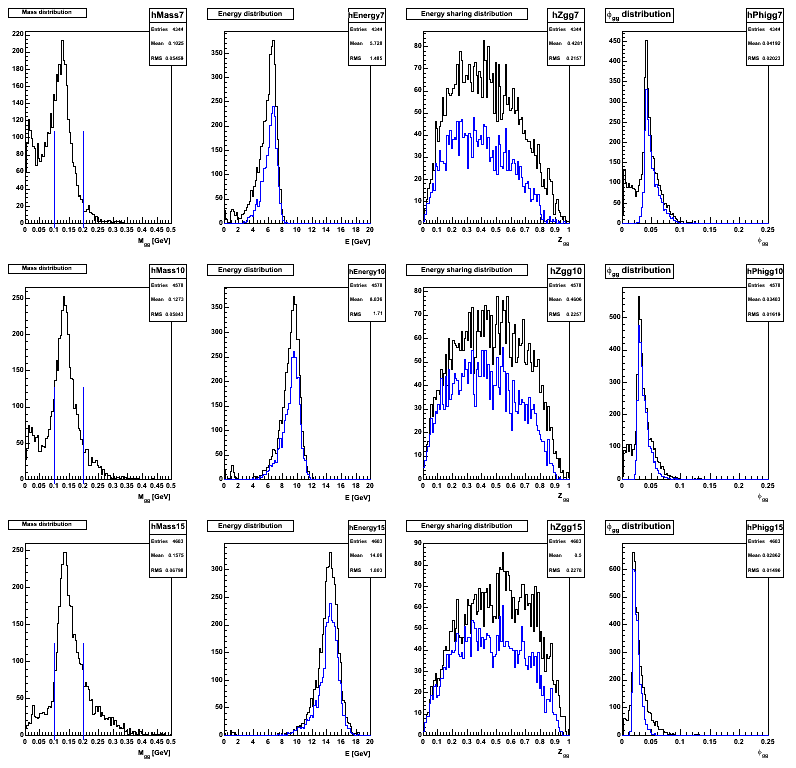
Some selected fits from the 10 GeV event sample
TO DO
- Count number of peaks above a threshold in each plane. Use to reject π0 &arrow; e+ e- γ (2%) and events which shower early.
- Understand why we are losing energy at lower masses... may need to tune up cluster thresholds... may be artifact of "old" cluster finder in chain.
















